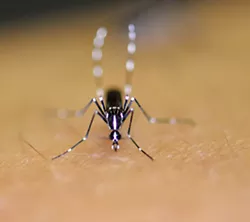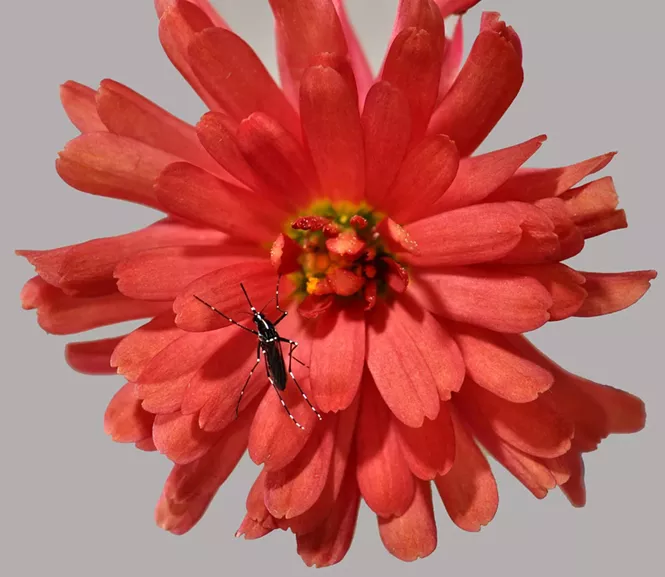
- Courtesy
- Ary Faraji, Ph.D., Salt Lake City Mosquito Abatement District entomologist
Ary Faraji is an entomologist who, for 18 years, has studied mosquitoes and the diseases that they transmit. As assistant manager and entomologist with the Salt Lake City Mosquito Abatement District, he has been closely following news of the mosquito-borne Zika virus.
Why is the Zika virus showing up right now?
Zika virus is not a new disease. It’s an illness that scientists refer to as an emerging or re-emerging vector-borne zoonotic disease. A vector is an agent, like a mosquito, that can carry and transmit an infectious pathogen to another living organism, and zoonotic refers to an infectious disease in an animal that can be transmitted to humans. So historically, Zika virus has been largely confined to equatorial Africa in the tropics where it circulated predominately between forest dwelling mosquitoes and wild primates. The virus was actually discovered from a sentinel rhesus monkey that had been placed in a cage on a tree platform in the Zika forest of Uganda in 1947. But the virus rarely caused spillover infections into human populations, even in highly endemic areas of Africa. The current explosive pandemic re-emergence that we are witnessing is therefore truly noteworthy. Human activities are probably the greatest factor attributing to this spread because of rapid changes in land use and globalization leading to rapid increases in the movement of goods and people.Why is the Zika virus, which used to be found in a narrow equatorial area, spreading to the point it is being called a pandemic? Are the mosquitoes migrating?
The virus infections are being called a pandemic because they are no longer confined to Africa. The virus has spread to Asia, the Pacific Islands, and now Central and South America. The virus is not continent-hopping via the spread of mosquitoes, but rather because of the frequency and rapidity of air travel by humans. It is not unlikely for an individual to become bitten by an infected mosquito in an area where the virus is circulating, and then hop on a plane and land in a new area within a short span of time. Since the incubation period in humans may last several days, if that infected individual is bitten by a local mosquito that can replicate and transmit the virus (we call this vector competency in the mosquito), then local infections in a new area may occur. But it is important to note that only a few species of mosquitoes are vector competent for Zika virus. The primary vectors for Zika virus are the yellow fever mosquito (Aedes aegypti) and the Asian tiger mosquito (Aedes albopictus, pictured). Both of these mosquitoes are considered as invasive urban species, because their eggs may remain dormant for months in small containers such as tires, and they are transported around the globe in these containers and establish new infestations where they settle.
- Ary Faraji
- Feeding time: Aedes albopictus mosquito
Will Utah mosquitoes eventually become carriers of it?
The short answer is no. Currently, the climate in Utah (severe cold winters) is too harsh for the establishment of Aedes aegypti or Aedes albopictus, which are primarily tropical or sub-tropical species. However, temperate and cold hardy populations of Aedes albopictus have successfully invaded the eastern United States, as far north as Massachusetts, and global climate change may eventually allow the establishment of this species even in Utah. Our local mosquito species (we have 51 of them in Utah and 16 in Salt Lake City) have not been shown to be vector competent for Zika virus. The virus has evolved for millions of years alongside its natural mosquito vectors in Africa, our mosquito species may possess biological, ecological, and immunological defenses against Zika virus. Nonetheless, I should state that one can never conjecture what could happen when a new virus is introduced into a new area and new ecosystem, with new vectors and new hosts. But the possibility of Zika virus establishing in Utah is very slim right now.What should Utahns be more concerned with: the West Nile or Zika virus?
West Nile virus is by far the greatest threat to Utah residents during the summer and fall. West Nile virus is now endemic in our state and will continue to be maintained in a natural transmission cycle between mosquitoes and birds annually. Spillover into human populations is what concerns us every year, and that is why Mosquito Abatement Agencies exist: to protect the comfort and public health of our residents through monitoring and control of mosquito species so that human infections are rare. Although infections with West Nile virus may be mild in most healthy individuals, the disease can cause serious neurologic manifestations in others and even lead to death (the highest number of deaths in Utah were during 2006 when 5 individuals died because of West Nile virus). Overall, the average annual incidence of West Nile virus neuro-invasive disease is rather low in Utah (about 0.3 to 0.5 per 100,000 people), but we are one of the few states to benefit from organized mosquito control agencies.If a Utahn visits a country where the virus is common and gets infected with Zika, then returns to Utah with the infection, is it possible it will spread through Utah mosquitoes?
The short answer, again, is no. None of our local mosquito species have been shown to be capable of picking up the virus from an infected blood meal, replicating the virus, and re-transmitting the virus to another host.Could the virus infect the local blood supply if infected people donate blood?
The viremic (infectious virus) stage of Zika virus is usually only a few days, but may last a bit longer in some people. As with any blood-borne pathogen, transmission through contaminated blood is always a possibility. However, this is a very unlikely scenario, and if Zika virus ever reaches epidemic stature in the United States, blood collection agencies will screen all donated blood for the virus (similar to what they already do for West Nile virus). Additionally, another relatively new discovery related to Zika virus has been the sexual transmission of the disease, probably due to survival of the virus in semen. A colleague from Colorado State was studying mosquitoes in West Africa during 2009 and was bitten by mosquitoes. After returning home to the USA and getting to know his wife once again, in a biblical sense, he fell ill and was diagnosed with Zika virus infection. His wife subsequently became ill as well and was diagnosed with the same infection. This was the first documented sexual transmission case ever for a mosquito-borne disease. But the chances of this occurring in a large population is also very unlikely at this point.Is Zika, then, mostly a major risk for pregnant women?
Any person living or travelling to an area where Zika virus is currently circulating may be at risk for infection, including pregnant women. But the good news is that an estimated 80 percent of persons infected with Zika virus are asymptomatic. Symptomatic disease is rare and if it occurs, it is generally mild and characterized by acute onset of fever, rash, joint pain, and conjunctivitis (red eyes). Severe disease requiring hospitalization or death is uncommon. But the ongoing epidemic of Zika virus in Brazil has been associated with Guillain-Barre syndrome, a muscle weakness caused by damaged peripheral nerves, in adults and by newborns being delivered with microcephaly, reduced brain size, apparently as a result of their mothers being infected during pregnancy. It is important to note that definitive proof between Zika virus and microcephaly or Guillain-Barre syndrome has not been determined, as both may be caused by a variety of other environmental and genetic factors. Additional studies are under way to further investigate these associations. However, the Centers for Disease Control and Prevention is recommending special precautions to pregnant women (in any trimester) to postpone travel to areas with high Zika virus activity or to take extra steps for the prevention of mosquito bites if travel is unavoidable.Can an ultrasound detect any abnormalities in the fetus caused by the Zika virus?
Yes, although microcephaly is most often diagnosed after a baby is born, it can also be diagnosed during pregnancy. The ultrasound test should be conducted late in the second trimester or early in the third trimester.Are there any vaccinations or antidotes on the horizon for the virus?
Although a vaccine is currently being worked on, it will not be available (if at all) for human use until the end of 2017. Most mosquito-borne viruses do not have a vaccine or preventative medication available for them. The best prevention is the avoidance of mosquito bites.What is local government doing to keep the virus at bay?
Mosquito control is a dynamic process that varies greatly between states or countries. Because no vaccine exists for Zika virus, mosquito control is the only effective means of suppressing mosquito populations and reducing disease cases during epidemics. But unfortunately, the mosquito vectors primarily responsible for Zika virus transmission are found throughout much of the Americas, including southern and eastern parts of the United States (although local infestations have been documented in parts of southern and central California). These mosquitoes thrive in small container habitats within close proximity to people in urban centers and will preferentially feed on humans over other hosts. The control of these species is very difficult because unlike most native mosquito species that thrive in floodwater habitats, which are predictable, these container-inhabiting mosquitoes are found in residential backyards where access is difficult and the habitats are everywhere (unpredictable). Traditional mosquito control measures have not been effective against these species. As a result, local governments are currently collaborating with various disciplines (mosquito control agencies, public health stewards, medical doctors, biologists, ecologists, virologists, policy makers…) in order to curtail the spread of Zika virus and prevent another public health emergency.What is it about mosquitoes that intrigues you?
Mosquitoes are the true vixens of the insect world. Some species are absolutely beautiful and mesmerizing, and yet can carry debilitating and deadly diseases with global impact. They are by far the deadliest animal on our planet, having determined the outcomes of war for thousands of years. In fact, more soldiers have succumbed to the diseases that they carry, than actual swords or bullets. Most people assume that mosquitoes (which, by the way, is Spanish for “little fly”) are just flying syringes, but this could not be farther from the truth. They are rather a complex biological organism with detailed processes for finding hosts to feed on; they have chemical defenses and enzymes to desensitize their host and prohibit blood from clotting (which is why you develop a welt and itch after a mosquito bite); their beak (proboscis) is not a needle, but rather composed of minute saws and tubes that can pierce and bend to find a capillary to feed on; they possess advanced immune systems to ward off infections (which is one of the reasons why they cannot transmit HIV); they can hibernate like a bear; fly long distances; and some eggs may remain dormant for years, just waiting for the right environmental conditions to hatch and repopulate an area. Only female mosquitoes will bite (they need the nutritious blood meal to develop eggs), while both males and females will feed on sugar sources like flowers and rotting fruit. And not all mosquitoes are bad, most help pollinate flowers, they provide food for other organisms, and some mosquito species even prey and feed on other mosquitoes in their juvenile (larval) stages. The list goes on, but it is simply amazing to have a small creature with so much death and wonder wrapped up into one.
- Ary Faraji
- Aedes albopictus mosquito on flower
What’s the best advice for not contracting the disease? Stay north?
Avoid areas where virus activity is currently high. If not, protect yourself from mosquito bites. Wear long sleeve shirts and pants, treat or purchase clothing with a built in repellent such as permethrin, treat exposed areas of your skin with an EPA approved mosquito repellent, and stay indoors during active mosquito periods. And above all, stay calm and carry on.